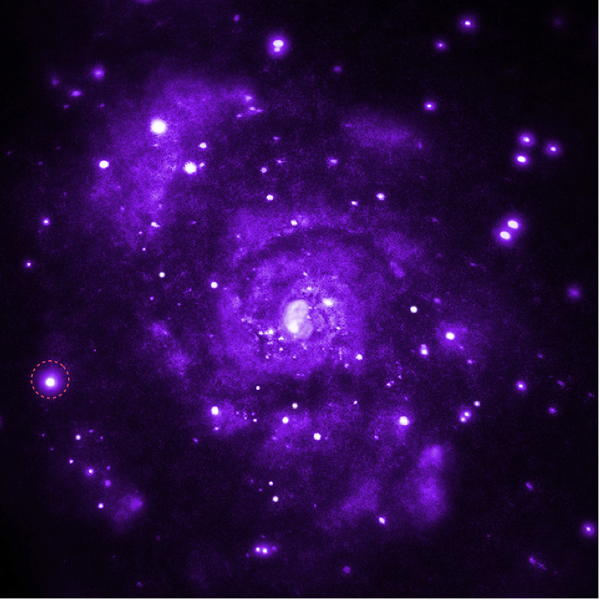
 Credit: X-ray: NASA/CXC/Caltech/M. Brightman et al.
Credit: X-ray: NASA/CXC/Caltech/M. Brightman et al.
Beyond the Brightness
A puzzle of contemporary X-ray astronomy is the nature of the so-called Ultraluminous X-ray Sources, or ULXs. A ULX is defined as an object that shines so brightly in X-rays that the momentum of the X-ray photons themselves should blow the source apart, if its mass falls in the normal range for a compact object or star. Many astronomers have suggested that ULXs represent a new class of astrophysical objects, so-called intermediate mass black holes having masses of hundreds or thousands of times the mass of the Sun. However, recent observations by the NuSTAR X-ray observatory have detected periodic variations in the X-ray brightness in at least a handful of ULXs. These periodic variations show that these ULX sources must be spinning, rapidly accreting neutron stars, objects with masses of just a bit more than the mass of the Sun. But in order for the neutron star to accrete enough matter to produce the observed X-ray emission, the neutron star should have an exceedingly strong magnetic field to funnel enough accreting material onto the compact object.
Astronomers have now used data from the Chandra X-ray Observatory to study the Ultraluminous X-ray source known as ULX 8 in M51, the Whirlpool Galaxy. The image above shows a beautiful Chandra image of the Whirlpool Galaxy in X-rays, with ULX 8 at the center of the dotted circle. Observations of the X-ray brightness with X-ray energy from ULX 8 show an usual dip in the X-ray emission, confined to a narrow energy range. This is a clear signature of a population of electrons swirling around an extremely strong magnetic field. The Chandra observations helps confirm the interpretation that strongly magnetized neutron stars can explain some, if not all, of these mysterious ultra-luminous sources.
Published: March 5, 2018
<
HEA Dictionary ● Archive
● Search HEAPOW
● Other Languages
● HEAPOW on Facebook
● Download all Images
● Education ● HEAD
>

Each week the HEASARC
brings you new, exciting and beautiful images from X-ray and Gamma ray
astronomy. Check back each week and be sure to check out the HEAPOW archive!
Page Author: Dr. Michael F. Corcoran
Last modified Monday, 26-Feb-2024 17:22:25 EST


